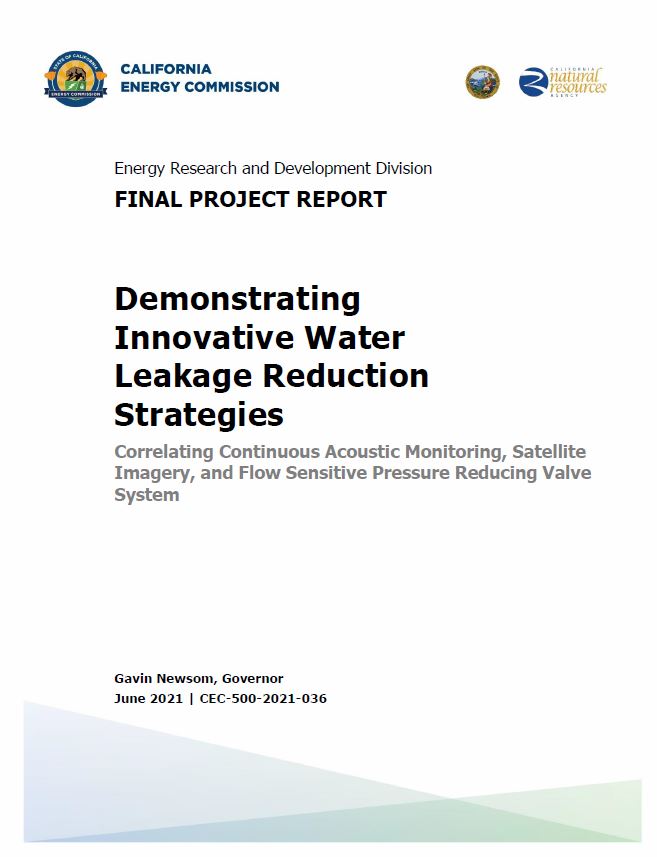Blogs
Finding Leaks: The Role of Satellite Leak Detection
December 22, 2021


The California Energy Commission (CEC) published a final project report entitled “Demonstrating Innovative Water Leakage Reduction Strategies” in June 2021. The report compares correlating continuous acoustic monitoring (CCAM) systems with Satellite Imagery and flow-sensitive pressure reducing values to determine the efficacy of each solution when it comes to finding leaks. Demonstrating Innovative Leakage Reduction Strategies is the final report for Contract Number EPC-15-096 conducted by Hazen and Sawyer and American Water. The publication Number is CEC-500-2021-036. The information from this project contributes to Energy Research and Development Division’s EPIC Program. For more information about the Energy Research and Development Division, please visit the CEC’s research website or contact the CEC at [email protected].
The project team installed and evaluated the latest in advanced correlating continuous acoustic monitoring technology, satellite imagery leak detection, and flow-sensitive pressure reducing valve systems to reduce water leakage and prevent water loss in California water utility networks. Because of the embedded energy in water pumping and treatment, reduced water loss directly correlates with reduced energy loss. The evaluation was a cooperative effort with the vendors to improve the developing tools. During the project, the team also evaluated the financial and water/energy saving benefits associated with the technologies and provided guidance for utilities to evaluate the technologies for applicability to other systems.
Water utilities struggle with identifying leaks in buried pipe infrastructure. The cost of repairing pipe leaks is relatively low when compared to replacement, but water utilities often do not know a pipe is leaking until the water reaches the surface. When leaks do not surface immediately, substantial water loss and subsurface damage can occur. While reported leakage tends to be associated with major surface expression of water and infrastructure damage, hidden leakage and unreported leakage are a challenge to detect and manage. Along with the waste of water, is the waste of energy associated with producing that water.
Significant water loss associated with aging infrastructure and long lag times from leak inception to detection results in not only wasted water but also wasted energy due to the high level of energy required to treat and deliver water intended for consumption. It is estimated that leak detection saves as much as 16,000 kWh/MG, based on the average energy intensity required for conveying (7000 kWh/MG), treating (8050 kWh/MG) and distributing water (950 kWh/MG) in California. This amount of energy saving mitigates 3,872 kilograms of carbon dioxide equivalent per million gallons (kg CO2eq/MG) prevented loss (8,606 lbs. CO2eq/MG prevented loss). State authorities estimate that California’s water distribution systems lose up to 228 billion gallons of potable water annually from leakage or broken underground pipes, translating to 3,648 million kWh/year and 1,207,500 metric tons of greenhouse gas emissions/year. Deploying technologies to identify leaks as soon as they occur would not only facilitate the task of water leak detection in distribution systems, but also assist water agencies in more efficient loss control strategies.
The purpose of this project was to evaluate technologies that could mitigate the formation of distribution system leaks and detect any leaks that do occur early enough to minimize water loss and damage. Specifically, this project aimed to provide a means by which water utilities could minimize wasted energy associated with the energy intensity of water due to leaks in the system, providing a net benefit to water and electricity ratepayers.
For this project, American Water, with support from Hazen and Sawyer for field supervision, detailed analysis, and project coordination, evaluated four technologies and methods to detect and prevent leaks:
The CCAM and satellite leak detection technologies were tested at the California American system in Duarte, California. The system in Duarte consists of approximately 100 miles of potable water pipeline and is located in the Los Angeles area. Each technology identified points of interest or possible leak locations. Pertinent leak investigation data such as leak location, the technology that found the leak, and leak size was collected in a project database.
The satellite system was provided by ASTERRA (formerly Utilis). This technology uses satellite based L-band radar to detect the signature of potable water leaks underground, namely moist or wet soil. This specific di-electric signature can be detected by the reflected radar signal and points of interest of likely leaking locations (POI/LLL). These areas are then inspected by trained boots-on-the-ground (BOTG) leak detection field crews to pinpoint the leak so it can be excavated and repaired.
During the course of this one-year study over 500 POI/LLs were identified by the satellite leak pre-location methodology. Only 146, or 29%, of the POI/LLLs were field investigated due to time and labor constraints. 117 leaks were found pursuant to the 146 POI/LLLs being investigated. This is a hit rate of 80%. Eighty percent of the locations identified by the satellite imagery analysis yielded a leak when inspected by field crews. This is in contrast to the CCAM system where 77 POIs were provided and 49 were investigated. 20 leaks were found for a net hit rate of 41%. This side-by-side comparison is significant because both systems were tested at the same time and on the same pipeline. The same BOTG leak detection crews were used to attempt to pinpoint the leaks. All potential biases were eliminated from the trial and the ASTERRA system was twice as good as the CCAM system at finding leaks.
The CEC report did not incorporate a value analysis into the study. However an article published in Water Finance & Management magazine in April 2019 it was reported that the cost to find one leak using the CCAM method was $7927 while the cost to find one leak using the satellite method was $774. This is due to the high capital cost of the CCAM system and the relatively low hit rate.
The CEC study shows that the ASTERRA/Utilis satellite system is more technically efficient at finding leaks and provides a much better value proposition than does the CCAM system.